
By Bill Gustin
Part 1 was published in the April 2017 issue.
This article examines how the theft of electricity, down power lines, and metal fences can cause electricity to take a dangerous and unexpected path. I have seen some very creative ways to steal electricity from the power company; most involve tapping into the electrical service before the meter. There have been several cases in my department’s jurisdiction where electrical thieves dug up and tapped into an underground electrical service. Their motivation is usually to supply the substantial amount of power necessary to illuminate the large array of sodium vapor lights for their marijuana “grow house” operation (photo 1).1
Firefighters in my battalion operating at a mobile home fire complained of being shocked when they contacted the trailer’s aluminum siding. How was this possible when the power had been shut off at the main circuit breaker? A close examination of the electric service wires from the utility pole revealed an extension cord crudely connected to one of the 110-volt wires. Theft of electricity can be hard to detect. Thieves like to tap into service wires obscured by tree foliage.
![(1) Wires to an electrical panel illegally connected to underground electrical service supply power to an array of sodium vapor lights in a marijuana “grow house.” [Photo courtesy of Miami-Dade (FL) Fire Rescue.]](https://emberly.fireengineering.com/wp-content/uploads/2017/05/1705FE_GustinPhoto1.jpg) |
| (1) Wires to an electrical panel illegally connected to underground electrical service supply power to an array of sodium vapor lights in a marijuana “grow house.” [Photo courtesy of Miami-Dade (FL) Fire Rescue.] |
Recently, my company responded on a medical call. While waiting for an ambulance to arrive, I noticed that two electric meters for the front and rear houses on the property next door were missing and that the service wires had been cut. That’s not an unusual sight in my company’s district. What was unusual is that I could hear a window air-conditioner running (photo 2). On further investigation, we found hidden in the tall grass three extension cords that were connected just below the meter assembly (photos 3-4). The three wires, two 110-volt “hot” legs and one neutral, were wrapped in electrical tape (photo 5) and run up the utility pole in the front of the house (photo 6), where they were connected to the power company’s wiring (photo 7).
After several months of customers not paying an electric bill, the power company will disconnect an electric service by pulling the meter and replacing it with a plastic protective cover; eventually, the power company will cut the electric service wires. That doesn’t faze some customers who will think of ingenious ways to tap into free electricity.
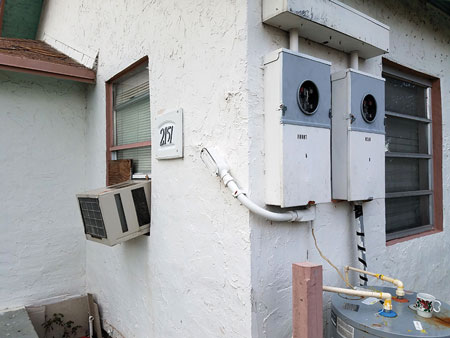 (2) This window air-conditioner was running even though the electric service wires had been cut and there were no electric meters. Firefighters suspected theft of electricity. (Photos 2-7 by James Dupre.) (2) This window air-conditioner was running even though the electric service wires had been cut and there were no electric meters. Firefighters suspected theft of electricity. (Photos 2-7 by James Dupre.) |
Companies in my battalion responded to a report of smoke coming from the roof of a house. Firefighters found the insulation on a coil of Romex™ cable and a portion of the flat roof’s rubberized single-ply membrane burning (photo 8). On further investigation, it was apparent that the thief skinned about 12 inches of insulation off the cable and fashioned it into a hook and then climbed a tree and hooked the end around one of the power company’s 110-volt legs (photo 9, arrow). The “electrician” then connected the Romex™ to his electrical service (photo 10) and used “jumper” wires to bridge across the terminals of the meter “can” (housing) (photo 11).
Down Power Lines and Energized Fences
Falling wires in contact with metal fences is a common hazard for firefighters. Common causes of down wires include high winds, vehicles striking utility poles, and fires. Additionally, my department experiences an increase in down wire calls on extremely hot days when the demand for electricity to run air-conditioning puts a strain on the electrical grid. Occasionally, civilians in the area have told us that they saw a huge flash and heard a loud boom just before their power went out. The culprit was a dead, severely burned squirrel lying at the base of the utility pole. His fatal mistake was bridging between wires.
While operating at fires, firefighters must not only be vigilant of wires that have already fallen but also of intact wires that may fall if they are in the path of an extending fire. If you are fighting a well-involved wood-frame structure fire, expect the fire to bring down wires that can fall on personnel, fences, or apparatus. Similarly, radiant heat from a large volume of fire burning through a roof or blowing out of show windows in a commercial building can burn and bring down the wires running across the front of a building.
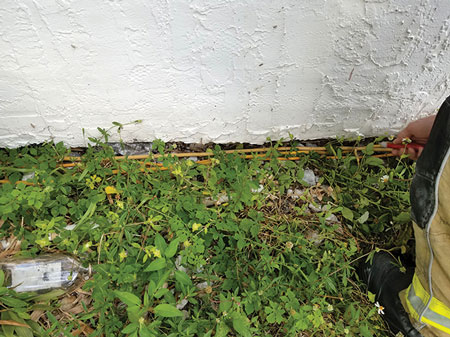 (3-4) Three extension cords for “improvised” electric service wires: two 110-volt “hot” wires and one neutral. (3-4) Three extension cords for “improvised” electric service wires: two 110-volt “hot” wires and one neutral. |
A building collapse can also cause wires to fall from radiant heat or because the utility poles are in the collapse zone. My Dad, who was a lieutenant on the Chicago Fire Department, was almost killed when a wall collapsed on him while he was operating the turntable controls of an aerial. The wall that buried him and the aerial in bricks also struck a utility pole, which brought down large transformers and commercial three-phase electrical service wires. Although he was critically injured by falling bricks, he also sustained deep and severe electrical burns.
When positioning apparatus, keep in mind the potential for falling wires. One of the most vulnerable positions is an apparatus spotted under electric service wires connected to a pole across the street from the fire building. If fire brings the service wires down, they will remain energized and will fall on the apparatus.
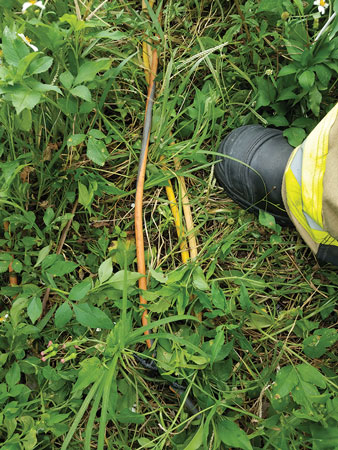
Treat every down wire as if it were energized. Ask your local utility company if it has a function that will automatically shut down a grid, deenergizing wires for a period of five minutes or more, and then automatically reenergize the grid. This function, I am told, is to stop the arcing of wires contacting each other in high winds.
An off-duty firefighter in my department stopped to help a vehicle accident victim whose car had collided with a MAT transformer. Civilians assisting the seriously injured driver were touching the accident vehicle, but they must not have been in contact with it when the firefighter began to help the victim. Suddenly, the grid automatically reenergized, electrocuting the firefighter.
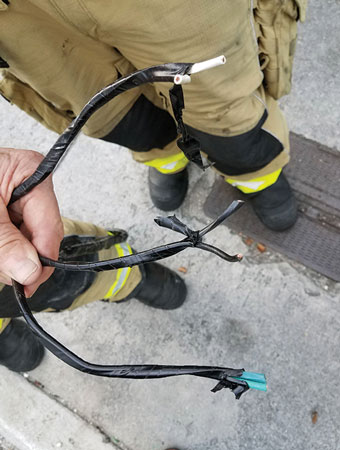 (5-6) Three extension cords wrapped in electrical tape were run up this utility pole. (5-6) Three extension cords wrapped in electrical tape were run up this utility pole. |
A few years ago, my company was dispatched to a report of wires down. As we arrived, we could see from the cab of the apparatus that a wire was down on the sidewalk. Before we could exit the cab, I heard the Fire Alarm Office dispatch another company to a report of wires down two blocks away. Since there was no storm, I assumed that it was a duplicate call, that a mistaken citizen was reporting our wires down at the wrong address. I told the alarm office to cancel the other company and that I would have a firefighter walk the two blocks to confirm that it was the wrong location. I made an embarrassing mistake that could have gotten someone killed: There were wires down two blocks away.
Since I try to make every mistake an opportunity to learn, I asked the power company linemen how wires could fall in two locations so close to each other when there was no storm. The linemen explained that it was most likely a “fault surge.” This can occur when a falling wire contacts another wire. The result is that the falling wire can send a surge of electricity to the other wire and bring it down at its weakest point.
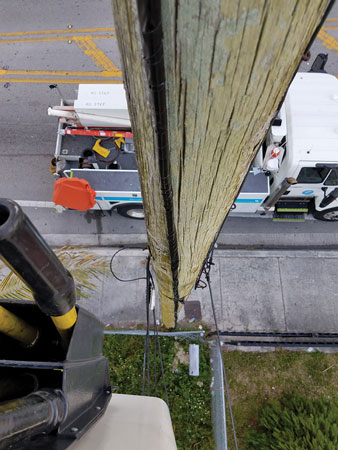
When responding to a report of down power lines, suspect that wires have fallen somewhere on a metal fence and that the fences in front of several homes could be energized. Additionally, warn residents, especially children, to stay indoors. Remember, a fence might not be energized at the moment, but it could suddenly become hot when the power grid is automatically reenergized.
Companies in my battalion responded in the early morning hours to a report of a home electric meter on fire during an intense thunderstorm. When one of the first-arriving firefighters attempted to open the gate to the chain link fence in front of the house, he was almost knocked off his feet. No one could see the wires down on the fence in the backyard. The firefighter, who could have been electrocuted, is a big man and was wearing full personal protective equipment and almost new rubber boots. Had he been a small child, the outcome would have been tragic. Never underestimate how far current can travel in energized fences. At this incident, volt meter readings indicated that fences in front of every house on the block were energized.
 |
| (7) This illegal electric service is connected to utility company wires. |
In photos 12-13, a primary wire carrying several thousand volts had fallen on this fence. What is frightening is that the down wire is several hundred feet from this fence gate where the photo was taken. Again, do not underestimate how far dangerous current can travel in an energized fence.
At this point, I must make something perfectly clear: Thermal imaging cameras (TICs) cannot detect electrical current and should never be used for that purpose. The image seen in the TIC in photo 13 is the heat from the electrical resistance of the chain.
Current Traveling Through Soil
Pure, dry soil is a poor conductor of electricity, but that is not the case in my department’s jurisdiction. The soil in Southeast Florida, because of the climate, low elevation, and proximity to the Atlantic Ocean, has a high moisture and salt content, which makes it a relatively good conductor. Current from faulty wiring or energized piping can travel through soil in this region for a considerable distance, and I understand from experienced electricians that there is no shortage of paths it can take.
Electricians tell me that errant current traveling through soil can find pipes; can travel up a ground rod driven into the ground; and is extremely attracted to steel road mesh in a concrete slab, driveway, or sidewalk. This helps us to understand what happened in the following incident.
![(8) Burning insulation on the Romex™ nonmetallic cable ignites the rubberized membrane roof covering. <i>[Photos 8-10 courtesy of Miami-Dade (FL) Fire Rescue.]</i> (9) The arrow indicates where the Romex™ cable is hooked over a 110-volt wire to steal electricity from the power company. (10) This Illegal connection of wires to electric service was cut by the power company for nonpayment of the electric bill. (11) “Jumper” wires bridging terminals in the meter “can” supply this house with free electricity. (Photo by James Dupre.)”></td>
</tr>
<tr>
<td align=](https://emberly.fireengineering.com/wp-content/uploads/2017/05/1705FE_GustinPhoto8.jpg) (8) Burning insulation on the Romex™ nonmetallic cable ignites the rubberized membrane roof covering. [Photos 8-10 courtesy of Miami-Dade (FL) Fire Rescue.] (8) Burning insulation on the Romex™ nonmetallic cable ignites the rubberized membrane roof covering. [Photos 8-10 courtesy of Miami-Dade (FL) Fire Rescue.] |
My company was dispatched to an “electrical problem.” When we arrived, the homeowner told us that she had had electrical problems, such as shocks and lights dimming, for months but everything got worse after she had cable TV installed the day before. Additionally, she complained of sparks coming from a wire she thought was installed by the cable company worker.
We found what appeared to be a ground wire running from the newly installed cable to conduit on the side of the house. It looked as if the conduit went from inside the house, underground, and then up to an outside light fixture. The wire was connected to the conduit with a cable clamp that was extremely loose and causing sparks.
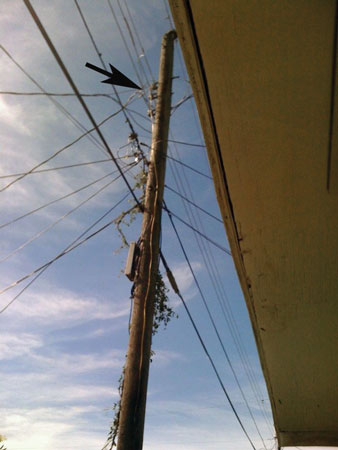 |
| (9) The arrow indicates where the Romex™ cable is hooked over a 110-volt wire to steal electricity from the power company. |
While we were waiting for the power company, one of the firefighters standing on the sidewalk at the side of the house happened to lean against a chain link fence and received a powerful shock. From his reaction, we thought he had been electrocuted. The power company lineman determined that the conduit to the outdoor light fixture was energized and was probably the cause of or a symptom of the family’s electrical problems.
Why was the firefighter shocked when he touched the fence? One explanation could be that current traveled from the energized conduit underground, went through the soil, found a path in the steel road mesh of the sidewalk, and then made its way to the fence. Why no family member was ever shocked is unknown; perhaps it’s was just luck that they didn’t touch the fence.
The Sparking Fence
Neighborhood residents complained to firefighters that they saw sparks coming from a chain link fence. The firefighters were skeptical until they saw sparks when someone kicked the fence. Their first thought was that a wire had fallen on the fence, but the weather was clear. One of the company members had a voltage detector, a simple and inexpensive device that illuminates and beeps when it detects current. The detector indicated that the sparking fence was energized, which was to be expected. What was not expected is that the fences in front of every home on the block were also energized. When the power company arrived, the lineman knew he had a serious situation on his hands and called for a supervisor.
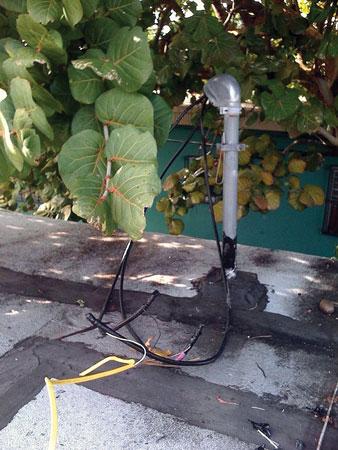 |
| (10) This Illegal connection of wires to electric service was cut by the power company for nonpayment of the electric bill. |
What the power company found was startling: Its meters detected significant voltage on the water meter of every home on the block. The power company supervisor suspected that a substantial source of power flowing through the soil found the water main and fences as a path. First, he had to eliminate the power company’s equipment as the source. His personnel examined underground wiring and MAT transformers in the area and found no problem. Additionally, there were no continuity problems with the power company’s neutral in the area.
The supervisor asked residents if there was any construction or excavating in the area. One resident replied that the only work that he knew of was the church at the corner had recently paved a new parking lot. The new parking lot was illuminated with 220-volt sodium vapor lights. The source of this havoc was discovered when an examination of underground wiring to the parking lot lights indicated that they were improperly installed and grounded.
Lessons Learned and Recommendations
Any fire in a concealed space such as under a floor or in a wall, a ceiling, an attic, a roof, or a soffit should be considered electrical until proven otherwise. If electricity is suspected, do not touch gas pipes, metal lath, conduit, BX, or any metal structural members. Additionally, consider the risk of placing aluminum ladders against energized flashing, rain gutters, or aluminum siding.
When an open neutral is suspected, open walls and ceiling cautiously and conservatively until the power company has confirmed that there is no power to the building. Also, avoid the use of metal tools, such as steel roof hooks and halligans. Remember that shutting off mains, tripping breakers, pulling fuses, and even cutting electric service wires to a building do not guarantee that the building is safe from electrical power.
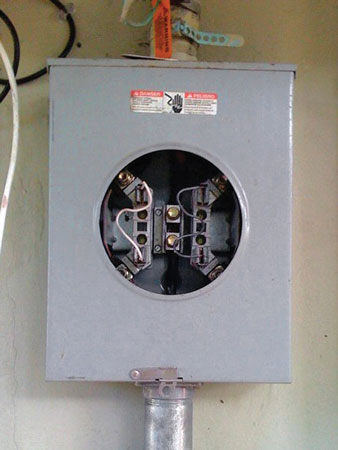 |
| (11) “Jumper” wires bridging terminals in the meter “can” supply this house with free electricity. (Photo by James Dupre.) |
Lights that flicker and dim and plumbing and appliances that give shocks are good indications of an open neutral or faulty bonding and grounding. It is important to understand that bonding and grounding can be improper or absent without any indication of a problem.
Lightning, wires falling on a building, faulty grounding, and open neutrals can and have ignited more than one fire in a building. For example, when you encounter sparks or fire involving an electric meter or service wires on the exterior of a building, you must gain entry to check the building’s electrical panels and attic.
![(12,<b> 13) </b>The thermal imaging camera’s view of electrical resistance heating the chain on the energized fence. Note: It is very important for firefighters to understand that a TIC cannot detect electrical current and should never be used for that purpose. [Photos courtesy of Pompano Beach (FL) Fire Rescue Department.]”></td>
</tr>
<tr>
<td align=](https://emberly.fireengineering.com/wp-content/uploads/2017/05/1705FE_GustinPhoto12.jpg) (12, 13) The thermal imaging camera’s view of electrical resistance heating the chain on the energized fence. Note: It is very important for firefighters to understand that a TIC cannot detect electrical current and should never be used for that purpose. [Photos courtesy of Pompano Beach (FL) Fire Rescue Department.] (12, 13) The thermal imaging camera’s view of electrical resistance heating the chain on the energized fence. Note: It is very important for firefighters to understand that a TIC cannot detect electrical current and should never be used for that purpose. [Photos courtesy of Pompano Beach (FL) Fire Rescue Department.] |
When you have the slightest suspicion that a fence or any metallic object is energized, make the initial contact with the back of one hand; if the object is energized, the muscles will tend to involuntarily contract inward and pull the hand away from the current. This advice comes with no guarantee, but it is far better than grasping an energized object and not being able to let go.
When on EMS calls, consider the possibility that an unconscious person may be a victim of electrocution. In recent years, there have been several incidents in which people were electrocuted when they contacted a fence, a manhole to underground wiring, or a bus bench enclosure. Lighting to a bus bench enclosure’s advertising can be improperly grounded and cause a shock or an electrocution. Similarly, suspect that an unconscious person in an attic may have been electrocuted and that the body may still be energized. Tragically, a brother firefighter in the Miami area was electrocuted while attempting to install an attic ventilation fan.
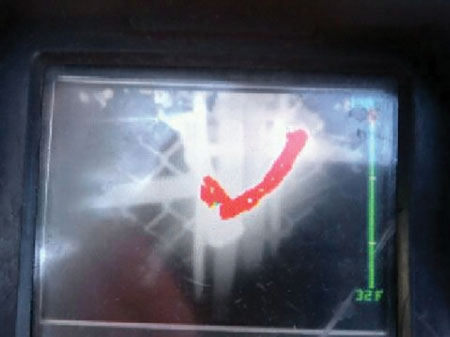
All fire companies should be equipped with voltage detectors, and it is critical that personnel be trained in their proper operation and fully understand their capabilities and that they are not 100 percent foolproof. For example, the power produced by photovoltaic panels is direct current, and power to light rail systems is DC. Is the voltage detector capable of detecting DC voltage?
This should go without saying: Firefighters should never use a voltage detector to determine that a down power line is not energized and return to quarters before the arrival of the power company. Firefighters must also realize that they do not have to make physical contact with a high-voltage power line to be electrocuted. It can be difficult at times for firefighters, accustomed to taking immediate action, to take no action. This is definitely the case with a fire in an electrical vault or a substation where your priorities must be to isolate the area, deny entry, and await the arrival of the power company.
Reach Out
The primary mission of a fire department is, and will continue to be, to protect communities and the lives of its citizens from fire. Clearly, fire suppression, taking action when a fire occurs, is a critical and definitely the most dangerous function fire departments perform to fulfill their mission. Fire suppression in itself, however, cannot totally protect a community and its citizens from fire. For fire departments to fully carry out their mission to protect lives and property, they must act before a fire occurs with prefire planning, fire prevention, and educating the public on how to prevent and protect themselves from fire.
Similarly, today the public expects the fire department to solve more problems than fighting their fires. Fire departments have become multihazard/multiservice agencies – look no further than EMS. The public has expectations, often unrealistically high, that firefighters are going to help them solve their problems. When water is leaking from a broken pipe or citizens get shocked when they touch a water pipe, their first call is often not to a plumber or an electrician but to the fire department. Because today’s firefighters must know more than just firefighting, they must reach out to professionals outside the realm of firefighting for information.
For example, firefighters can derive a wealth of knowledge on electrical problems by reaching out to electricians and electrical inspectors. Firefighters are not electricians; it is not their job, and they are not qualified to fix electrical problems. Firefighters can, however, learn from electrical professionals to recognize and mitigate electrical hazards to protect themselves and the public. Additionally, firefighters who reach out to electrical professionals will have a better understanding of the risks when electricity takes an unexpected path.
Endnote
1. See, “The Hazards of Grow Houses,” Gustin, Bill, Fire Engineering, June 2010.
BILL GUSTIN is a 44-year veteran of the fire service and a captain with Miami-Dade (FL) Fire Rescue. He began his fire service career in the Chicago area and is a lead instructor in his department’s Officer Development Program. He teaches tactics and company officer training programs throughout North America. He is a technical editor of Fire Engineering and an advisory board member of FDIC International.
When Electricity Takes an Unexpected Path, Part 1
Electrical Hazards: Is Your Department Prepared?
UNDERSTANDING ELECTRICITY AND ELECTRICAL DANGERS
More Fire Engineering Issue Articles
Fire Engineering Archives

